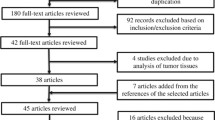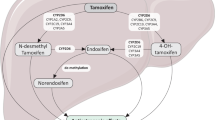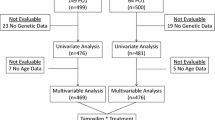Abstract
The aim of this study is to evaluate the impact of CYP2D6 genotyping in predicting disease-free survival and toxicity in breast cancer patients treated with adjuvant tamoxifen. DNA from 91 patients was genotyped using the AmpliChip CYP450 GeneChip®, Roche that facilitates the classification of individuals by testing 27 alleles. When patients were grouped into group 1 (*4/*4, *4/*41, *1/*5 and *2/*5) and group 2 (the remaining genotypes), a significant difference in disease-free survival (DFS) was observed between groups (P = 0.016). The mean DFS in group 1 was 95 months in contrast with 119 months in group 2. No significant relationship was found between the CYP2D6 genotype classification and severe, mild or no toxicity (P = 0.2). Nevertheless, severe, and mild toxicity was more frequent among poor metabolizer patients than in patients with a normal metabolizer pattern (18.8 and 43.8% vs. 10.7 and 36%, respectively). In breast cancer, patients treated with adjuvant tamoxifen, non-functional and severely impaired CYP2D6 variants are associated with a worse DFS and with a higher frequency of severe and mild toxicities. Larger studies of the CYP2D6 genotype-clinical outcomes association are needed to complement initial results.

Similar content being viewed by others
References
Osborne CK (1998) Tamoxifen in the treatment of breast cancer. N Engl J Med 339:1609–1618. doi:10.1056/NEJM199811263392207
Early Breast Cancer Trialists’ Collaborative Group (EBCTCG) (2005) Effects of chemotherapy and hormonal therapy for early breast cancer on recurrence and 15-year survival: an overview of the randomized trials. Lancet 365:1687–1717. doi:10.1016/S0140-6736(05)66544-0
Stearns V, Johnson MD, Rae JM et al (2003) Active tamoxifen metabolite plasma concentrations after coadministration of tamoxifen and the selective serotonin reuptake inhibitor paroxetine. J Natl Cancer Inst 95:1758–1764
Sachse C, Brockmöller J, Bauer S et al (1997) Cytochrome P450 2D6 variants in a Caucasian population: allele frequencies and phenotypic consequences. Am J Hum Genet 60:284–295
Kubota T, Yamaura Y, Ohkawa N et al (2000) Frequencies of CYP2D6 mutant alleles in a normal Japanese population and metabolic activity of dextromethorphan O-demethylation in different CYP2D6 genotypes. Br J Clin Pharmacol 50:31–34. doi:10.1046/j.1365-2125.2000.00209.x
Griese EU, Asante-Poku S, Ofori-Adjei D et al (1999) Analysis of the CYP2D6 gene mutations and their consequences for enzyme function in a West African population. Pharmacogenetics 9:715–723. doi:10.1097/00008571-199912000-00006
Menoyo A, del Rio E, Baiget M (2006) Characterization of variant alleles of cytochrome CYP2D6 in a Spanish population. Cell Biochem Funct 24:381–385. doi:10.1002/cbf.1258
Home Page of the Human Cytochrome P450 (CYP) Allele Nomenclature Committee (www.cypalleles.ki.se)
Miller SA, Dykes DD, Polesky H (1989) A simple salting out procedure for extracting DNA from human nucleated cells. Nucleic Acids Res 16:1215. doi:10.1093/nar/16.3.1215
Raimundo S, Toscano C, Klein K et al (2004) A novel intronic mutation, 2988G > A, with high predictivity for impaired function of cytochrome P450 2D6 in white subjects. Clin Pharmacol Ther 76:128–138. doi:10.1016/j.clpt.2004.04.009
Nowell SA, Ahn J, Rae JM et al (2005) Association of genetic variation in tamoxifen-metabolizing enzymes with overall survival and recurrence of disease in breast cancer patients. Breast Cancer Res Treat 91:249–258. doi:10.1007/s10549-004-7751-x
Wegman P, Vainikka L, Stal O et al (2005) Genotype of metabolic enzymes and the benefit of tamoxifen in postmenopausal breast cancer patients. Breast Cancer Res 7:R284–R290. doi:10.1186/bcr993
Goetz MP, Rae JM, Suman VJ et al (2005) Pharmacogenetics of tamoxifen biotransformation is associated with clinical outcomes of efficacy and hot flashes. J Clin Oncol 23:9312–9318. doi:10.1200/JCO.2005.03.3266
Goetz MP, Knox SK, Suman VJ et al (2007) The impact of cytochrome P450 2D6 metabolism in women receiving adjuvant tamoxifen. Breast Cancer Res Treat 101:113–121. doi:10.1007/s10549-006-9428-0
Schroth W, Antoniadou L, Fritz P et al (2007) Breast cancer treatment outcome with adjuvant tamoxifen relative to patient CYP2D6 and CYP2C19 genotypes. J Clin Oncol 25:5187–5193. doi:10.1200/JCO.2007.12.2705
Author information
Authors and Affiliations
Corresponding author
Rights and permissions
About this article
Cite this article
Ramón y Cajal, T., Altés, A., Paré, L. et al. Impact of CYP2D6 polymorphisms in tamoxifen adjuvant breast cancer treatment. Breast Cancer Res Treat 119, 33–38 (2010). https://doi.org/10.1007/s10549-009-0328-y
Received:
Accepted:
Published:
Issue Date:
DOI: https://doi.org/10.1007/s10549-009-0328-y




